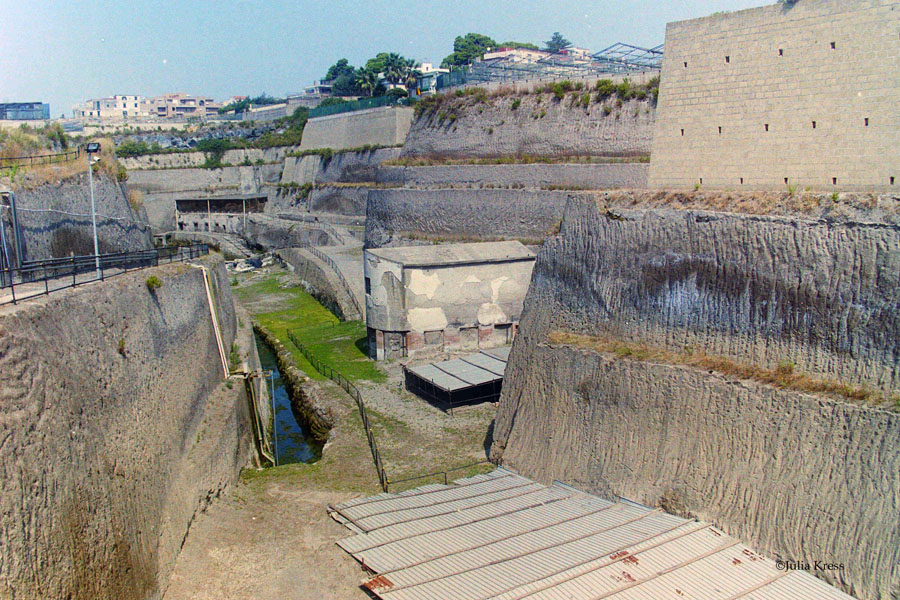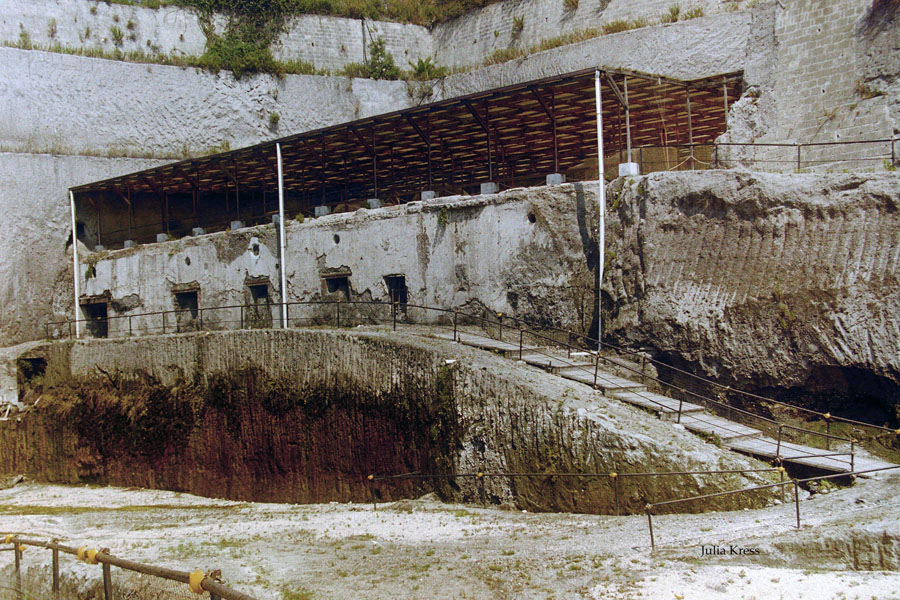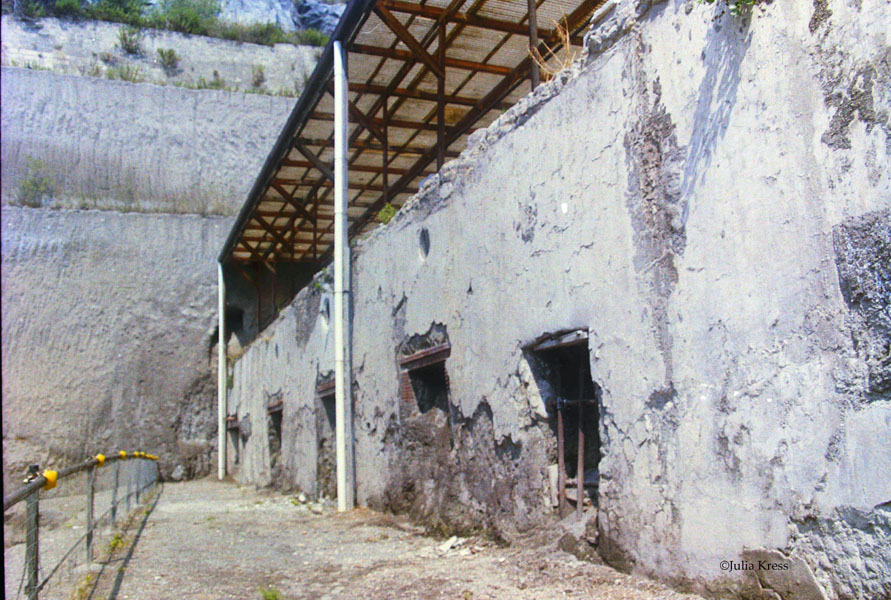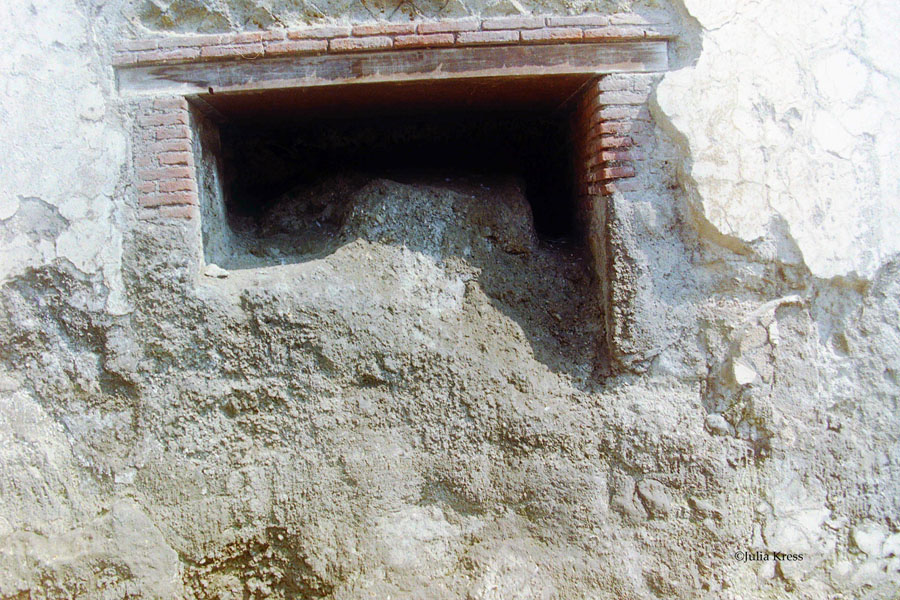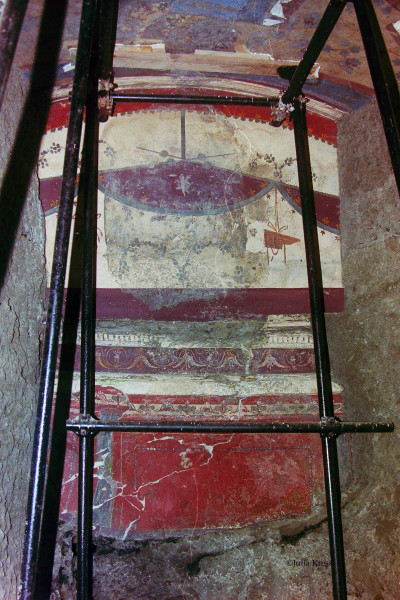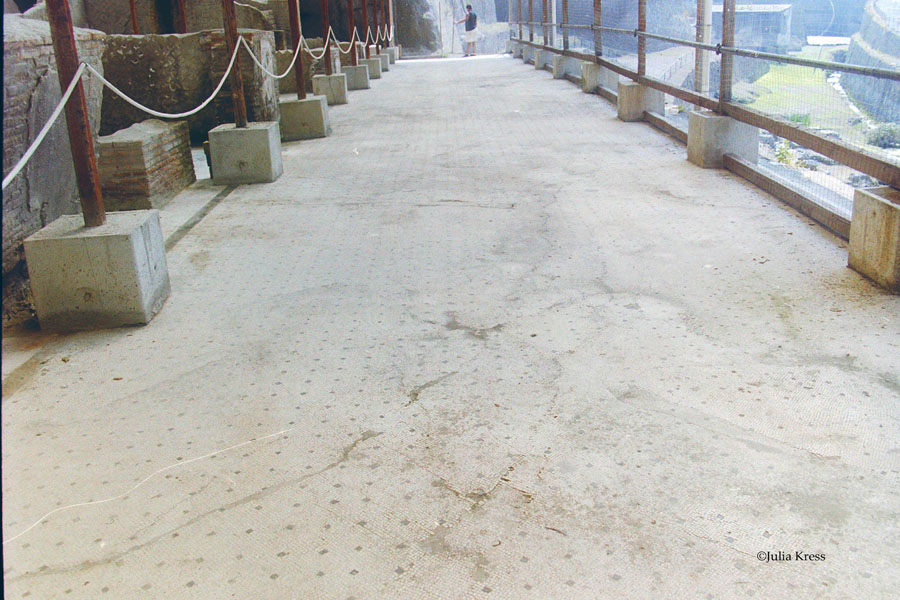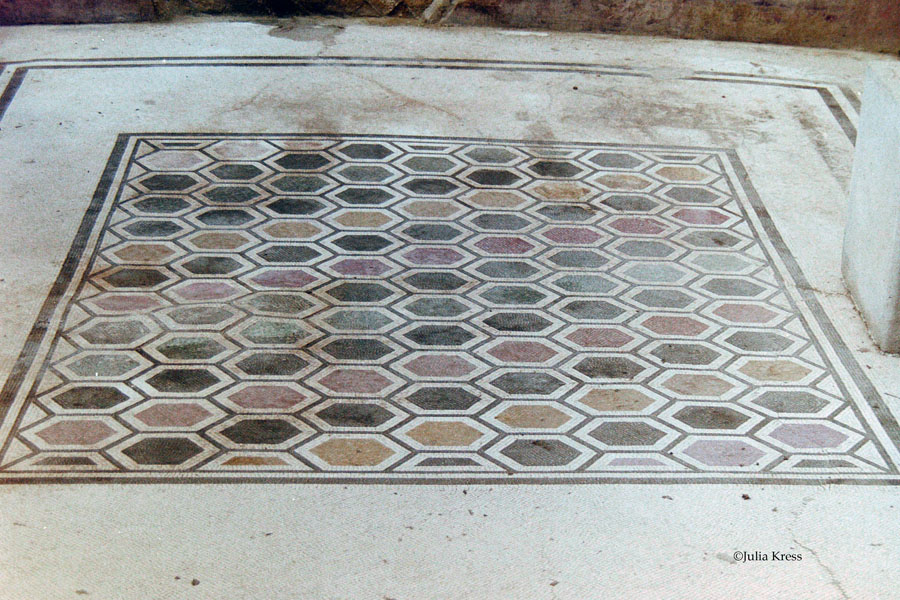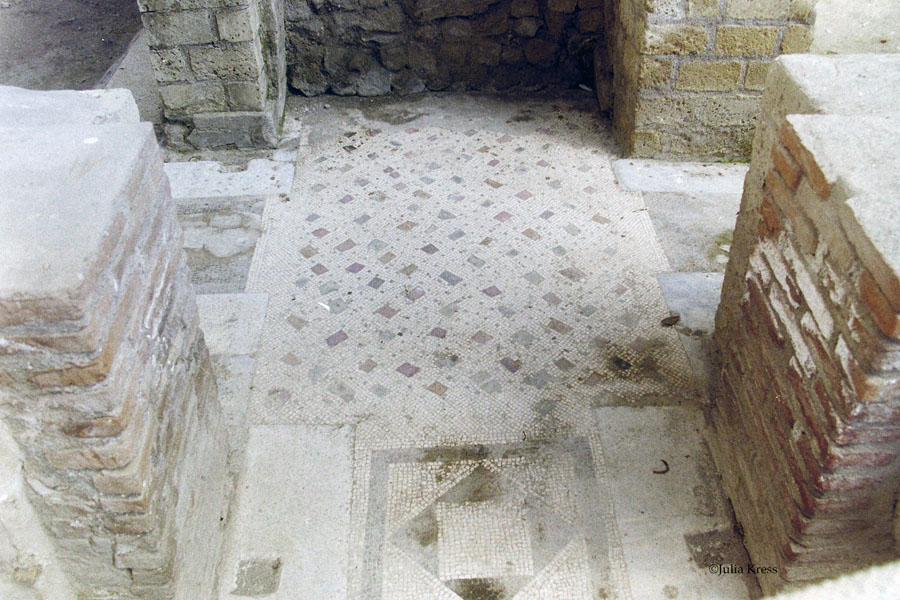
New technologies make the impossible possible so that carbonized scrolls can be digitally read
Collage of photos showing the Villa dei Papiri main building (far left) to the tunnel leading to Herculaneum (far right)
When Mt. Vesuvius erupted in 79 AD, it buried not just Pompeii but also the nearby city of Herculaneum (modern day Ercolano). A large luxurious villa, called the Villa dei Papiri (Villa of the Papyri), was partially excavated through tunneling in the 1750s. The unique finds include 1,100 papyrus scrolls that were carbonized into charcoal by the volcano’s eruption. This is the only intact library from antiquity to survive making these scrolls highly valuable. The challenge has been to read these scrolls. Various attempts to physically unroll the scrolls have been unsuccessful, resulting in only fragments being recovered. Most of the scroll fragments that are readable are primarily the work of Hellenistic Epicurean poet and philosopher Philodemus of Gadara.
Prof. Brent Seales and the Digital Restoration Initiative at the University of Kentucky are working with micro-CT scans and other advanced technology, including a machine learning algorithm, to reveal the carbon ink (distinguished by its lead content) on the scrolls to virtually unwrap them to reveal their contents. In August 2019, three scrolls traveled from the Biblioteca Nazionale di Napoli in Italy to the University of California, Los Angeles to be scanned in a sophisticated imaging lab. Seales and his team will use these scans to further develop a specialized computer learning tool designed to show the text wrapped within the scrolls without destroying them.
After being scanned at UCLA, the three scrolls were featured in the "Buried by Vesuvius: The Villa dei Papiri at Herculaneum" exhibit at the Getty Villa from June 26–October 28, 2019.
For More Information:
● The Getty Villa’s “Buried by Vesuvius: the Villa dei Papiri at Herculaneum" exhibit information
● Prof. Brent Seales and the Digital Restoration Initiative
Interesting Facts:
The Herculaneum scrolls that were found are held by four institutions. The Institut de France has six scrolls in its possession. The Bodleian Libraries at Oxford University has four scrolls in its collection. The British Library has eleven fragments and five scrolls. The remaining scrolls are at the Biblioteca Nazionale di Napoli.
The Getty Villa in Pacific Palisades, California is a reproduction (not a copy) of the Villa dei Papiri and has copies of the bronze statues placed in its garden where they were discovered in the Villa dei Papiri. J. Paul Getty built it to house his expanding art collection in the 1970s based off of drawings made by Karl Weber in the 18th century and other architectural elements found in ancient buildings around the Bay of Naples. See the Getty Villa’s website.
Articles of Interest:
● “Roman holiday, 40BC: an in-depth view of the Villa dei Papiri, the inspiration for the Getty Villa” by Andrew Wallace-Hadrill, The Art Newspaper, July 17, 2020.
● “Brent Seales Awarded Prestigious Mellon Grant, Poised to Solve 2,000-Year-Old Mystery” by Lindsey Piercy, University of Kentucky News, May 21, 2019.
● “Hidden Writing Revealed on Ancient Scroll Buried in Same Ash as Pompeii” by Eva Frederick, Science, Oct. 4, 2019 .
● “Buried by the Ash of Vesuvius, These Scrolls Are Being Read for the First Time in Millennia” by Jo Marchant, Smithsonian Magazine, July/August 2018.
● “The Charred Scrolls of Herculaneum” by Jason Urbanus, Archaeology, May/June 2015.
Enlightening Videos:
● "Lapilli sotto la Cenere del Parco Archeologico di Ercolano: Villa dei Papiri" (Under the ashes of the Archaeological Park of Ercolano: Villa dei Papiri), dated Oct. 7, 2020. This is the first video in a series (in Italian with English subtitles) from the Villa dei Papiri excavation site by the Archaeological Park of Ercolano.
● "Lapilli sotto la cenere del Parco Archeologico di Ercolano: Villa dei Papiri - Scavi borbonici," dated Oct. 28, 2020. This second video by the Archaeological Park of Ercolano focuses on the Bourbon excavations.
● "Lapilli sotto la cenere del Parco Archeologico di Ercolano: Villa dei Papiri - La Biblioteca," dated Nov. 11, 2020. The third video by the Archaeological Park of Ercolano shows the library remains and discusses the possible owner of the villa.
● "Lapilli sotto la cenere del Parco Archeologico di Ercolano: Terme nord occidental," dated Nov. 25, 2020. The fourth video by the Archaeological Park of Ercolano highlights the north baths discovered next to the Villa dei Papiri.
● “Herculaneum Scrolls: Unraveling History.” This video is about scientists digitally opening the Herculaneum Scrolls. Two minute preview, free. Subscription to Curiosity Stream required to view entire 20 minute video.
Books of Interest:
● “Buried by Vesuvius: the Villa dei Papiri at Herculaneum” edited by Kenneth Lapatin (J. Paul Getty Museum, 2019)
● “Cities of Vesuvius: Pompeii and Herculaneum” by Michael Grant (Phoenix Press, 1971)
● “Herculaneum: Italy’s Buried Treasure” by Joseph Jay Deiss (J. Paul Getty Museum, 1985)
● "Herculaneum: Past and Future" by Andrew Wallace-Hadrill (Packard Humanities Insitute, 2011)
● “Herculaneum: A Reasoned Archaeological Itinerary” by Mario Pagano T&M Srl (Torre del Greco Italy, 2000)
● “Inside Roman libraries: Book Collections and Their Management in Antiquity” by George W. Houston (The University of North Carolina Press, 2014)
● "The Library of the Villa dei Papiri at Herculaneum" by David Sider (J. Paul Getty Museum, 2005)
● “Philodemus in Italy: the Books from Herculaneum” by Marcello Gigante (University of Michigan Press, 1995)
● "The Villa dei Papiri at Herculaneum: Life and Afterlife of a Sculpture Collection" by Carol C. Mattusch and Henry Lie (J. Paul Getty Museum, 2005)
● “The Villa of the Papyri at Herculaneum: Archaeology, Reception, and Digital Reconstruction” by Mantha Zarmakoupi (De Gruyter, 2010)
Books of Interest in Italian:
● "Ercolano e la Villa dei Papiri: Archeologia, Città e Paesaggio" edited by Vieri Quilici and Giovanni Longobardi (Alinea, 2007)
● "Ecolano e la Villa dei Papiri" by Amedeo Maiuri (Novara, 1978)
● "La Villa dei Papiri" edited by Valeria Moesch (Electra, 2009)
● "La Villa dei Papiri" by Domenico Mustilli and Marcello Gigante (Napoli, 1983)
● "La Villa dei Papiri ad Ercolano: Contributo alla Ricostruzione dell'Ideologia della Nobilitas Tardorepubblicana" by Maria Rita Wojcik (L'Erma di Bretschneider, 1986)
Note:
Julia Kress visited Herculaneum twice and was able to visit the Villa dei Papiri excavations in Sept. 2005, when the photographs on this webpage were taken. For more information, please contact her at jekress@rice.edu.

Kress is pictured with the three papyri scrolls on display at the Getty Villa, Oct. 2019
